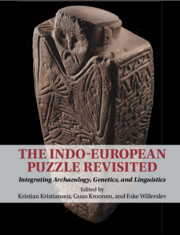Book contents
- The Indo-European Puzzle Revisited
- The Indo-European Puzzle Revisited
- Copyright page
- Contents
- Figures
- Tables
- Contributors
- Preface
- Introduction
- Part I Early Indo-European and the Origin of Pastoralism
- Part II Migratory Processes and Linguistic Dispersals between Yamnaya and the Corded Ware
- 5 The Corded Ware Complex in Europe in Light of Current Archaeogenetic and Environmental Evidence
- 6 Emergent Properties of the Corded Ware Culture: An Information Approach
- 7 Linguistic Phylogenetics and Words for Metals in Indo‑European
- 8 Word Mining: Metal Names and the Indo-European Dispersal
- Part III The Cultural and Linguistic Significance of Bell Beakers along the Atlantic Fringe
- Part IV The Bronze Age Chariot and Wool Horizons
- Part V Kinship Systems, Marriage, Fosterage, Free, and Unfree
- Concluding Reflections
- Index
- References
5 - The Corded Ware Complex in Europe in Light of Current Archaeogenetic and Environmental Evidence
from Part II - Migratory Processes and Linguistic Dispersals between Yamnaya and the Corded Ware
Published online by Cambridge University Press: 29 April 2023
- The Indo-European Puzzle Revisited
- The Indo-European Puzzle Revisited
- Copyright page
- Contents
- Figures
- Tables
- Contributors
- Preface
- Introduction
- Part I Early Indo-European and the Origin of Pastoralism
- Part II Migratory Processes and Linguistic Dispersals between Yamnaya and the Corded Ware
- 5 The Corded Ware Complex in Europe in Light of Current Archaeogenetic and Environmental Evidence
- 6 Emergent Properties of the Corded Ware Culture: An Information Approach
- 7 Linguistic Phylogenetics and Words for Metals in Indo‑European
- 8 Word Mining: Metal Names and the Indo-European Dispersal
- Part III The Cultural and Linguistic Significance of Bell Beakers along the Atlantic Fringe
- Part IV The Bronze Age Chariot and Wool Horizons
- Part V Kinship Systems, Marriage, Fosterage, Free, and Unfree
- Concluding Reflections
- Index
- References
Summary
Corded Ware is one of the main archaeological phenomena of the third millennium before the common era (BCE), with a wide geographic spread across much of central and northeastern Europe, from Denmark, the Rhineland, and Switzerland in the west to the Baltic and Western Russia in the east, and broadly restricted to the temperate, continental zones north of the Alps, the Carpathians, and the steppe/forest steppe border to the east (Glob 1944; Strahm and Buchvaldek 1991; Furholt 2014).
- Type
- Chapter
- Information
- The Indo-European Puzzle RevisitedIntegrating Archaeology, Genetics, and Linguistics, pp. 63 - 80Publisher: Cambridge University PressPrint publication year: 2023
References
- 8
- Cited by

